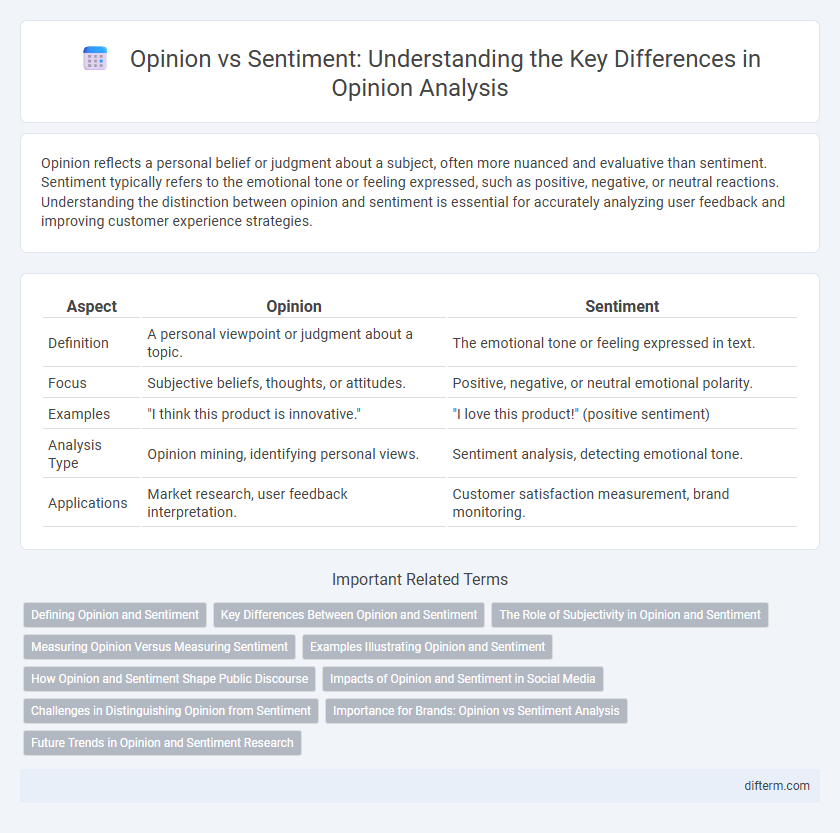Opinion reflects a personal belief or judgment about a subject, often more nuanced and evaluative than sentiment. Sentiment typically refers to the emotional tone or feeling expressed, such as positive, negative, or neutral reactions. Understanding the distinction between opinion and sentiment is essential for accurately analyzing user feedback and improving customer experience strategies.
Table of Comparison
| Aspect | Opinion | Sentiment |
|---|---|---|
| Definition | A personal viewpoint or judgment about a topic. | The emotional tone or feeling expressed in text. |
| Focus | Subjective beliefs, thoughts, or attitudes. | Positive, negative, or neutral emotional polarity. |
| Examples | "I think this product is innovative." | "I love this product!" (positive sentiment) |
| Analysis Type | Opinion mining, identifying personal views. | Sentiment analysis, detecting emotional tone. |
| Applications | Market research, user feedback interpretation. | Customer satisfaction measurement, brand monitoring. |
Defining Opinion and Sentiment
Opinion refers to a personal belief or judgment formed about a particular topic, reflecting an individual's perspective or evaluation. Sentiment captures the emotional tone or attitude expressed within a text, often categorized as positive, negative, or neutral. Defining opinion involves understanding subjective viewpoints, while sentiment analysis quantifies emotional polarity to gauge public mood.
Key Differences Between Opinion and Sentiment
Opinion refers to a personal belief or judgment shaped by individual experiences and reasoning, while sentiment reflects the emotional tone or attitude expressed in a text. Opinions are often explicit statements about a subject, whereas sentiment captures underlying feelings such as positivity, negativity, or neutrality. Understanding the distinction enables more accurate analysis in fields like sentiment analysis, opinion mining, and social media monitoring.
The Role of Subjectivity in Opinion and Sentiment
Subjectivity plays a crucial role in distinguishing opinion from sentiment, as opinion involves personal beliefs and judgments shaped by individual experiences. Sentiment primarily reflects the emotional tone or attitude expressed toward a specific entity or event. Understanding this distinction enhances the accuracy of natural language processing tasks, such as opinion mining and sentiment analysis, by enabling more nuanced interpretations of text data.
Measuring Opinion Versus Measuring Sentiment
Measuring opinion involves analyzing expressed judgments, beliefs, or evaluations about specific topics, providing insights into individual or collective viewpoints. Sentiment measurement quantifies emotional tone, categorizing expressions as positive, negative, or neutral, often relying on linguistic polarity detection. Distinguishing opinion from sentiment is critical for applications in market research and social media analysis to capture both the evaluative stance and underlying emotion accurately.
Examples Illustrating Opinion and Sentiment
Opinion reflects a person's beliefs or judgments about a subject, often expressed through evaluative statements like "The movie was captivating and thought-provoking." Sentiment captures the emotional tone underlying a statement, such as positive feelings in "I loved the atmosphere of the restaurant." For example, in product reviews, opinions include detailed assessments of features, while sentiment analysis detects overall positivity or negativity.
How Opinion and Sentiment Shape Public Discourse
Opinion reflects individual beliefs and values that influence public discourse by shaping arguments and perspectives, while sentiment conveys emotional tone that affects the reception and engagement of messages. Understanding the interplay between opinion and sentiment is crucial for analyzing social media trends, political debates, and consumer feedback. Public discourse evolves as collective opinions provide substance and sentiments drive emotional resonance, shaping societal attitudes and behaviors.
Impacts of Opinion and Sentiment in Social Media
Opinion and sentiment in social media significantly influence public discourse and consumer behavior, shaping brand reputations and political landscapes. Opinions represent explicit personal beliefs often expressed through detailed arguments, while sentiments reflect emotional reactions that drive engagement and virality. Analyzing both opinion and sentiment enables businesses and policymakers to understand audience attitudes, predict trends, and respond effectively to social dynamics.
Challenges in Distinguishing Opinion from Sentiment
Distinguishing opinion from sentiment involves challenges due to their overlapping yet distinct characteristics in natural language processing. Opinions often encompass evaluative judgments and subjective beliefs about entities or events, while sentiments primarily reflect the emotional tone, such as positive or negative feelings. Accurately separating these concepts requires sophisticated models capable of nuanced understanding, as standard sentiment analysis techniques may misclassify opinions that lack explicit emotional expressions.
Importance for Brands: Opinion vs Sentiment Analysis
Opinion analysis captures explicit expressions of personal beliefs or evaluations, providing brands with actionable insights directly tied to consumer preferences. Sentiment analysis measures the emotional tone behind text, helping brands gauge overall customer mood but often lacks nuanced understanding of specific opinions. Combining both approaches equips brands with a comprehensive view, enhancing product development, marketing strategies, and customer engagement.
Future Trends in Opinion and Sentiment Research
Future trends in opinion and sentiment research emphasize the integration of advanced natural language processing and machine learning to enhance accuracy in detecting nuanced human emotions and subjective viewpoints. Emerging techniques focus on multimodal data analysis, combining text, voice, and facial expressions to provide a holistic understanding of opinions and sentiments. Research also explores real-time sentiment tracking to support dynamic decision-making in marketing, politics, and public relations.
opinion vs sentiment Infographic

 difterm.com
difterm.com